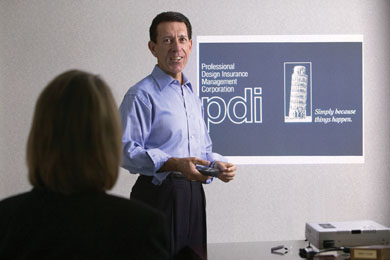
Professional Design Insurance executives (from left) Ken McComb, Vice President, and Terry Lee, President, at their Indianapolis offices.
Top carriers and underwriting savvy make PDI
a go-to market for design professionals E&O
By Elisabeth Boone, CPCU

|
Professional Design Insurance executives (from left) Ken McComb, Vice President, and Terry Lee, President, at their Indianapolis offices. |
The professionals who design and build structures, from a local convenience store to a towering skyscraper, face a host of exposures to loss as a project moves from blueprints to grand opening. Chief among these exposures are liability for design errors, erroneous cost estimates, structural failure, asbestos, and pollution.
Clearly, the business of arranging professional liability insurance for design professionals is not for amateurs. It’s a highly specialized field that demands a blend of underwriting skill, market knowledge, and familiarity with the operations and risks associated with design and construction.
A leader in this challenging specialty market, Professional Design Insurance (PDI) is the nation’s largest brokerage and underwriting manager specializing exclusively in arranging professional liability insurance for architects and engineers, design/build contractors, and environmental consultants. Based in Indianapolis, PDI was established in 1980 and is owned by shareholders Tom and Norma McComb, their son Ken, and Terry Lee. Lee, who joined the firm in 1985 after a career with Foremost Insurance, is president of PDI; McComb, who founded the agency, is making a gradual transition toward retirement. Ken shares marketing and underwriting responsibilities with Lee.
How and why did PDI come into existence? Lee explains: “My associate, Tom, was executive director of the Consulting Engineers of Indiana. He had a strong background in insurance, and the board gave him a mandate to find affordable professional liability coverage for members. He visited various insurance companies and ultimately worked with them to develop a facility that would first underwrite professional liability for the Indiana engineers group and then approach the executive directors of engineers societies throughout the country. That business was funneled through PDI, which acted as a broker on behalf of the engineering societies.”
Over the next few years, PDI evolved into a wholesale brokerage operation but continued to operate as a retailer in Indiana. Of PDI’s total volume, Lee says, some 35% is architects, 35% is engineers, 20% is design/build contractors, and the remaining 10% is environmental consultants. PDI operates with a staff of seven.
PDI uses domestic and London carriers to place coverage. PDI’s markets literally run the gamut from A to Z: ACE, AEIC, Gulf, Houston Casualty, Lexington, Lloyd’s, National Casualty, and Zurich. As an MGA for Arch Specialty Insurance, PDI has authority to write accounts with billings of up to $10 million. In addition to its markets for design professionals, PDI uses a number of other carriers for environmental consultants.
Support for retailers
Over the years, Lee says, PDI has transacted business through about 5,000 retail agents and, Lee continues, “we have fine tuned the services we render, so when a retail agent calls and says he has a risk but doesn’t know much about the class of business, I give him a quick course in Design Professionals 101. I explain the coverage, list the available markets, and tell the agent what premium range to expect for this type of client. I also tell the agent what he can expect his competition to bring to the table.” In essence, Lee says, “We bring the agent up to speed on this line of coverage, so he sounds knowledgeable when he talks to his client. Often we stay in the background; the architect or engineer might not even know that we exist.
“In all cases, we offer the agent and the insured some of the extra services we provide, such as contract review,” Lee continues. “When an architect is presented with a contract from his client and he has questions about the ramifications or implications of the contract for his professional liability coverage, he sends it to us and we review it. Our goal is to respond to that agent or client within two hours of receipt of the contract.”
Once PDI has provided this service, Lee comments, “typically the insured knows of our existence, and in many cases I’ll talk to the principal of the firm about other questions he has: ‘If I go into this area of architecture, will it negatively affect my premium?’ ‘What are the exposures I should consider if I accept this project?’ We quickly give the insured direct answers to these and other questions.”
 |
Terry Lee conducts an on-site loss prevention seminar for insureds. A service of PDI, the seminar includes a two-and-a-half-hour presentation that addresses a wide range of loss prevention issues. |
Another service PDI provides for insureds is an on-site loss prevention seminar, which involves a two-and-a-half-hour presentation that addresses a wide range of loss prevention issues. The insured has the opportunity to ask questions and discuss specific situations that are important to him. “We find the seminar is beneficial not only for the insured, who gets some highly specialized information he can’t get anywhere else, but also for the carrier, because it makes the client a better insured,” Lee remarks. “After the seminar, the insured is aware of potential traps and pitfalls, so he knows how to stay out of trouble and when to ask questions and express concerns.”
PDI also has developed a loss prevention manual. Every insured receives a copy, and Lee also leaves manuals with attendees at his loss prevention seminars.
At the retail agent’s request, Lee says, he’ll be happy to make a joint call on a larger client or prospect. “I frequently travel across the country and make a presentation with an agent to his client when he needs that added expertise at the table to win the business,” he says. “If all we did was give an agent an insurance policy and take his money and put it in the bank, we wouldn’t be doing justice to our mission, which is to do as much as we can for the insured and the agent,” Lee says.
A market in flux
Architects and engineers, design/build contractors, and environmental consultants are highly specialized risks that don’t find a home with just any carrier. Each of these classes is vulnerable to changes in the economy and the legal environment, among other influences. How would Lee characterize the market for these classes of business with respect to capacity, competition, and pricing?
Professional liability insurance for design professionals is a highly specialized field that demands a blend of underwriting skill, market knowledge, and familiarity with the operations and risks associated with design and construction. |
“As most people are painfully aware, since 9/11 prices have increased extraordinarily,” Lee responds. “Some 10 to 12 years ago, PDI developed a three-year policy for the architects and engineers market, and we placed a significant part of our book in those policies. Insureds loved the fact that they didn’t have to complete an application every year, and they knew what their insurance costs would be over three years so it was easy for them to project their expenses,” he explains. “Agents liked it because they had that client for three years and didn’t have to worry about competition. It was great for everybody. Unfortunately, when 9/11 hit, the reinsurance market decided it was not going to be on any three-year policies, and they went away overnight.”
A client who had a three-year policy that was up for renewal in the wake of 9/11, Lee says, experienced what could conservatively be described as extreme sticker shock. “In many cases, an insured wound up paying about the same amount for an annual policy as he paid for a three-year policy,” Lee notes. “Since 9/11, this market has continued to be hard, even though a lot of other lines have softened a bit.”
The hard market trend for design professionals E&O continues, Lee says, “but is being modified somewhat by carriers that are pricing business way below market value. In some cases, we find their pricing to be anywhere between 30% and 40% below the lowest quote on the table. Essentially, they are buying business—certainly nothing new in the insurance industry,” Lee remarks. “The biggest concern for the marketplace is that these insurers are seldom in the market for the duration, and when claims begin coming in, the carriers are gone.”
In this kind of market, Lee says, “there’s even more need for us to do everything right: to keep insureds happy by providing value-added services, and to deliver as comprehensive a policy as we can for the best possible price.”
Challenges abound
Design professionals face a myriad of concerns, Lee says, and these concerns translate into challenges for PDI. “The biggest challenge at the moment, especially in the architects and engineers arena, is claims,” he says. “Claims for this class of business are closely tied to the economy. When the economy gets very tight, we find that claims increase exponentially. Because the economy has been pretty tight since 9/11, claims have risen rather dramatically,” he observes.
As the stock market faltered and the economy weakened, Lee explains, design professionals began to experience an increase in claims. “I used to see that one in five, or maybe one in seven, firms had a claim,” he says. “Now it seems like almost every other file I pick up has had a claim. Our challenge today in the architects and engineers arena is to help our insureds keep their claim activity to a minimum by using loss prevention. When there is a claim, we need to get right on it and do as much as we can to mitigate the severity of that claim,” he says.
“The second challenge we face is that, again as a result of claims, structural engineers are very difficult to place,” Lee says. “There are many markets that will automatically decline a risk if there’s heavy involvement of structural engineering. The reason is that when a structural engineer has a claim, it’s going to be severe. An entire building or parking garage may be at risk because of a structural problem. It’s a real challenge for us to find markets that will consider structural engineers,” he says.
Yet another area of concern, Lee says, “is in the design/build area, where we’re working primarily with contractors. One of the aspects of design/build is construction management,” he says. “When a contractor is doing construction management, we have found that those claims have increased drastically over the past few years. As with structural engineering, there are many carriers today that will no longer write a firm that is doing construction management.”
 |
A small staff with big results—The PDI staff includes (standing from left) Tanya Cline, Assistant Underwriter; Terry Lee; Ken McComb; and (seated from left) Lori Harley, Administrative Assistant; and Melissa Hartman, Office Manager. |
A relationship business
Whatever challenges it encounters in its highly specialized market, Lee is confident that PDI has the markets, resources, and expertise to provide the coverages and services needed by retail agents’ design professional clients. “Our stable markets have always been our strength,” he declares. “For us, this is a business of developing relationships. We have excellent relationships with all the carriers we work with. I work hard to develop and maintain those relationships, and when the market gets tough, we have the relationships with carriers that lots of other firms don’t. At PDI, we have value for retail agents whether the market is hard or soft. When an agent has a piece of business that is really difficult to place, I can usually get it done for him. We pride ourselves on serving agents who can benefit from our experience and our carrier relationships.” *
For more information:
PDI
Phone: (317) 570-6945
Web site: www.pdiins.com